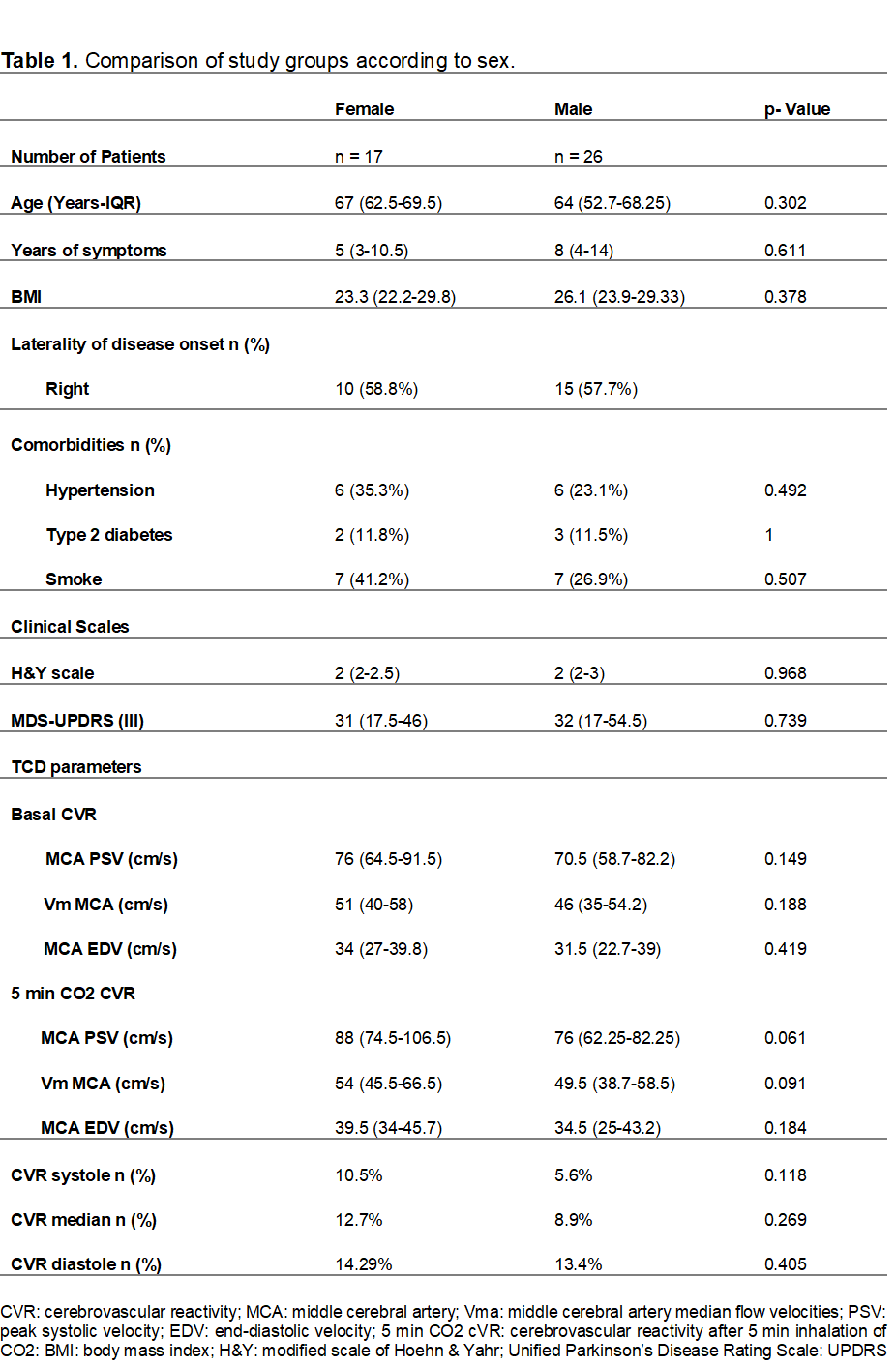Category: Parkinson's Disease: Neuroimaging
Objective: To determine sex differences in cerebral vasoreactivity (cVR) in patients with Parkinson’s disease (PD) and its association with the clinical spectrum of the disease.
Background: Sex is a known risk factor for PD, with males having an increased risk of developing the disease,[1] and females experiencing a later age at onset, more often with tremor and postural instability, as well as worse dyskinesia despite lower levodopa intake, especially in postmenopausal women.[2] CVR is a non-invasive marker of cerebrovascular disease, its impairment has been associated with a worse functional state in patients with PD. [3,4] However, sex differences in CVR impairment have seldom been reported in patients with PD. [5]
Method: A cross-sectional study was conducted from June 2022 through December 2023, recruiting Consecutive patients with a clinical diagnosis of PD seen at the outpatient Movement Disorders Clinic of our Hospital. Patients underwent clinical evaluation with MDS-UPDRS and transcranial Doppler ultrasound (TCD) to evaluate CVR. Those with carotid artery stenosis ( >50%), intracranial surgery, or inadequate transtemporal window were excluded. Impairment of CVR was defined as a difference <5% in mean blood flow velocity after 5 minutes of CO2 inhalation. Demographic and clinical characteristics were compared between males and females.
Results: Forty-three PD patients were included, with a median age of 66 years (IQR 56-68), of which 17 (39.5%) were female, and a median disease duration of 8 years. We found no significant differences in clinical variables between females and males. However, female PD patients had a trend towards higher CVR, but this difference did not reach statistical significance. [Table 1]
Conclusion: While female patients with PD exhibited a higher CVR, this difference was not statistically significant. Further studies are warranted to characterize possible sex-related differences in CVR and clarify their role in the PD outcome, which may influence management, tailored to meet the specific requirements of men and women with PD.
Table 1
References: 1. Rodriguez-Violante M, Velasquez-Perez L, Cervantes-Arriaga A. Incidence rates of Parkinson’s disease in Mexico: Analysis of 2014-2017 statistics. Revista Mexicana de Neurociencia. 2019;20(3):136-40. https://doi.org/10.24875/RMN.M19000043
2. D. Georgiev, K. Hamberg, M. Hariz, L. Forsgren. Gender differences in Parkinson’s disease: A clinical perspective. Acta Neurol Scand. 2017 Dec;136(6):570-584. https://doi.org/10.1111/ane.12796
3. Brisson, R. T., Fernandes, R. C. L., Arruda, J. F. L., Rocha, T. C. C. D. S. M., Santos, N. G. D., Silva, L. D., de Lima, M. A. S. D., & de Rosso, A. L. Z. Altered Cerebral Vasoreactivity on Transcranial Color-Coded Sonography Related to Akinetic-Rigid Phenotype of Parkinson’s Disease: Interim Analysis of a Cross-Sectional Study. Brain sciences, 2023; 13(5), 709. https://doi.org/10.3390/brainsci13050709
4. Zamani, B., Mehrabani, M., Fereshtehnejad, S. M., & Rohani, M. Evaluation of cerebral vasomotor reactivity in Parkinson’s disease: is there any association with orthostatic hypotension? Clinical neurology and neurosurgery. 2011; 113(5), 368–372. https://doi.org/10.1016/j.clineuro.2010.12.014
5. J. S. Minhas, R. B. Panerai, T. G. Robinson. Sex differences in cerebral haemodynamics across the physiological range of PaCo2. Physiol. Meas. 2018; 39, 105009. https://doi.org/10.1088/1361-6579/aae469
To cite this abstract in AMA style:
M. Cansino Torres, D. Ortiz Zacarias, A. Rodríguez Martínez, J. Trejo Ayala, S. Castillo Torres, F. Góngora Rivera, B. Chávez Luévanos, I. Estrada Bellman. Sex Cerebral Vasoreactivity Differences in Parkinson’s Disease: Uncovering the Tip of the Iceberg [abstract]. Mov Disord. 2024; 39 (suppl 1). https://www.mdsabstracts.org/abstract/sex-cerebral-vasoreactivity-differences-in-parkinsons-disease-uncovering-the-tip-of-the-iceberg/. Accessed December 27, 2025.« Back to 2024 International Congress
MDS Abstracts - https://www.mdsabstracts.org/abstract/sex-cerebral-vasoreactivity-differences-in-parkinsons-disease-uncovering-the-tip-of-the-iceberg/

